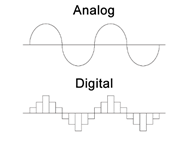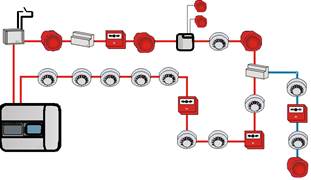
The analogue addressable fire detection systems have emerged to address these weaknesses of conventional detectors that can give false alarms in case of “condition changes like fire condition” such as cigarette smoke, rapid air movements and contamination. The analogue addressable detectors detect the analogue changes (smoke and heat) of the environment with sensors and continuously report the electrical values they detect to the fire control panel. The control panel records the values received from the detectors and monitors their change over time. It considers discontinuous sudden changes as a disruptive signal but does not switch to alarm state. Or, in case of very slowly emerging changes, it decides that this is a situation such as "cigarette smoke" or "contamination" and prevents false alarms. It is the ability of the system to process and evaluate these analogue changes, referred to as “analogue”.

In the analogue addressable fire detection systems, the control panel must communicate with each detector individually by using its own special type of communication method and record the detection values of each detector individually. The necessity of communication with all detectors during this specific type of communication, which can be expressed as scanning type communication, can increase the scanning time in electrical circuits (cycles) with high occupancy to a period of 3 seconds. This means that in case of fire, if we include confirmation and action start times, the total alarm generation time can be up to 10 seconds.
In the analogue addressable systems, since the control panel is the decision center of the system, all analogue addressable detectors in that cycle become completely inoperable if the communication between a detection cycle and the panel is lost for any reason.
In the analogue addressable systems, the detectors are generally single-sensor due to the limitation of the data transfer. (Ionization Smoke, Optical Smoke, Temperature Detectors, etc.) Although there are Analogue Addressable Combined Optical Smoke and Temperature Detectors in which two different sensors are present within a single detection area, these devices are monitored only if the temperature sensors in this sensor reach a higher level such as 60°C or 90°C. Thus, it is aimed to catch quickly-inflammable fires emitting low and black smoke that cannot be detected with the optical smoke sensors.
Since the analogue information is sent from the detectors to the control panels in the analogue addressable systems, it is necessary to make the loop circuits with shielded cables that provide protection against electrical interference and noise. The shielded cables are more expensive than the unshielded cables and require more attention and labor time in installation and assembly. The unshielded cable requirement also does not allow the use of existing unshielded cables in buildings with conventional or digital addressable fire alarm systems that are required to be renewed. The new cabling requirement makes renovation work difficult, expensive and sometimes impossible.

In the analogue addressable systems, detectors and other field elements are individually addressed with miniature coding keys underneath them. This is a feature that requires a lot of attention in the field and leads to a lot of time loss in case of incorrect addressing.
In the analogue addressable systems, the communication protocol between the fire detectors and the control panel limits the communication speeds and data processing capacities. This limitation prevents the improvement of the software running in the system using this technology.
Since the obligation to communicate with all devices individually means intensive communication, it is possible to apply a relatively limited number of detectors per cycle line and/or relatively shorter cycle line distances in a certain section depending on the number of devices in the analogue addressable systems.
Fire Detection and Alarm Systems from Past to Today »
Conventional Fire Detection and Alarm Systems »
Digital Addressable Fire Detection and Alarm Systems »
Distributed Intelligent Interactive Fire Detection and Alarm Systems »